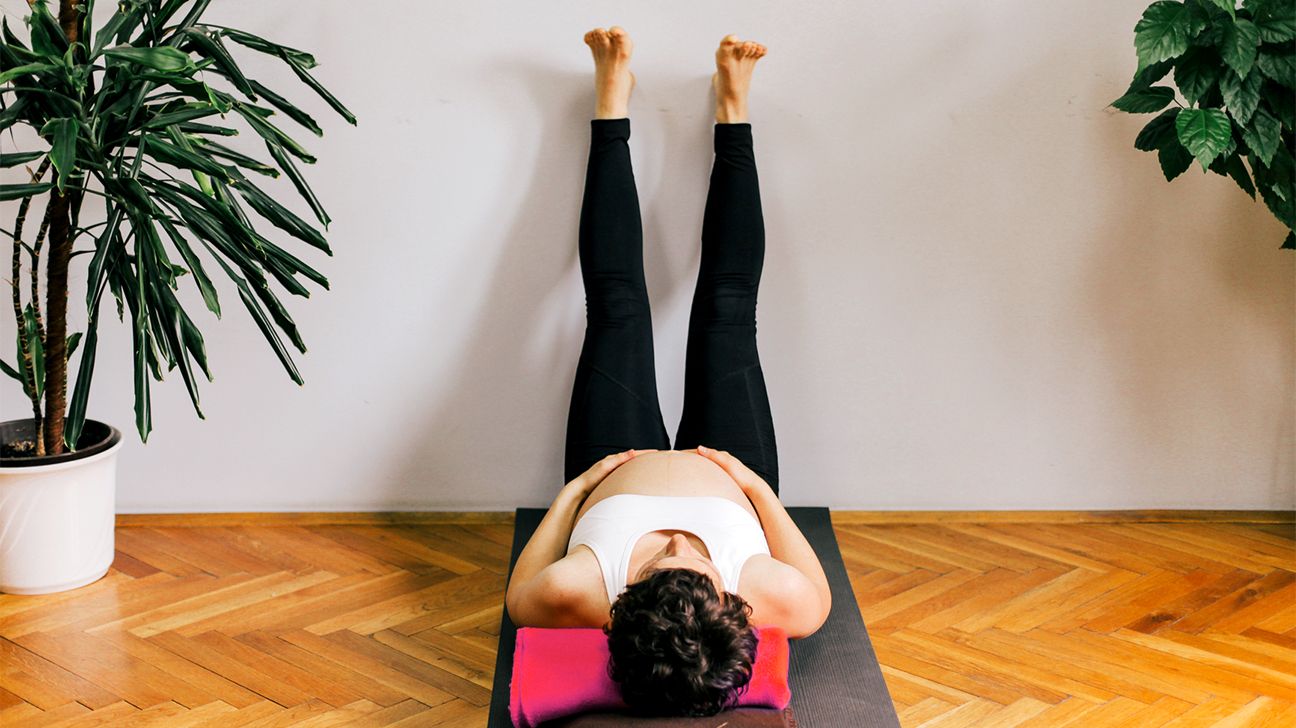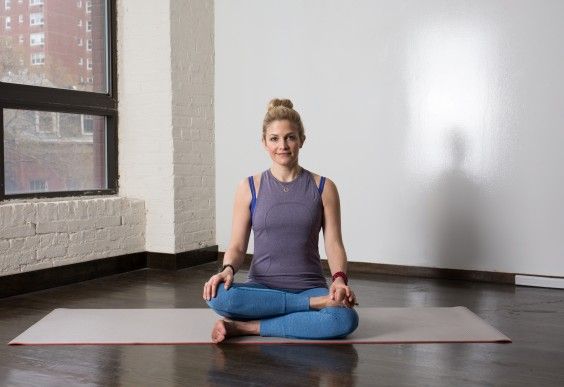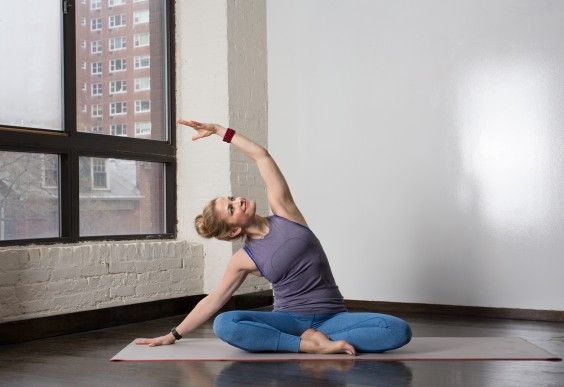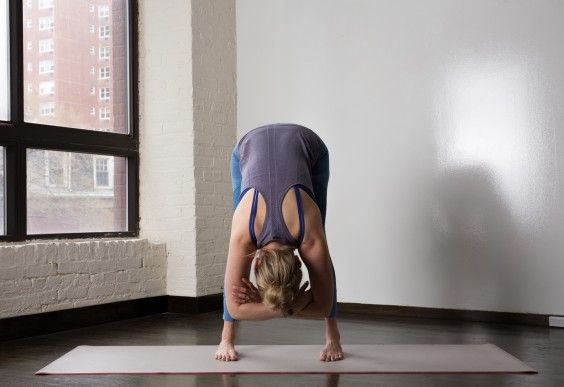You probably already know that staying active while pregnant can have all kinds of great benefits for you and your baby. Unless your doctor has told you otherwise, lots of forms of exercise — jogging, basic bodyweight strength moves, and more — can be perfectly healthy.
Yoga, in particular, can be awesome because it’s a perfect combination of stretching and strengthening, says Bec Conant, prenatal yoga instructor at Om Births and birth doula in Boston. (Fun fact: Four women have gone into labor during Conant’s classes.)
“Yoga does two things while you’re pregnant: It’s a physical form of exercise that’s also going to bring some mindfulness and awareness into how your body is changing on a daily level,” Conant says.
A 2014 study found that pregnant women who participated in a 6-week yoga program were more optimistic, felt stronger, and had better overall well-being.
If you’re feeling down or depressed while pregnant, research shows that prenatal yoga may help with that too.
Another plus: breath control. “You don’t need Lamaze if you go to yoga,” says Heidi Kristoffer, yogi, founder of CrossFlowX, and mom to adorable twins.
“Yoga makes you more conscious of what’s happening with your body — you’re not just checking out of what your body is feeling.”
With that in mind, we’ve rounded up 12 soothing poses to help relieve some of the most common pregnancy ailments, from tight hips to a sore lower back.
Bonus: These “ahh”-inducing postures will ease aches and pains even if you’re not pregnant. And in case you’re wondering, yes, Kristoffer practiced yoga throughout her pregnancy.
Note: If you’re pregnant or trying to get pregnant, check with your doctor before starting any new workout routine.
1. Ankle-to-Knee Pose
Sanskrit: Agnistambhasana
“For back pain, I always do hip openers,” Kristoffer says.
In addition to creating space for your belly and opening up your back, this pose will help relieve tension in your glutes and the muscles under your glutes, like the piriformis, Conant says.
How to do it
Sit with feet on the floor, knees bent, and shoulders relaxed. Slide flexed right foot under left knee, so right knee rests on the floor (like half of a regular cross-legged position).
Stack left shin on top of right, so left foot rests on right knee and left knee rests on right foot. Rest palms gently on knee and foot or bring them together to prayer (Anjali mudra).
For a deeper stretch, hinge forward. Switch leg placement and repeat on the other side.
2. Seated Side Bend
Sanskrit: Sukhasana variation
Any type of side bend will help a cranky back, Kristoffer says. Pick your favorite variation, with either crossed or open legs.
How to do it
Start in a comfortable upright seated position, with legs crossed or folded in a half-lotus pose. Allow right hand to rest comfortably on the floor.
Stretch left arm straight up, and then bend to the right, focusing on rotating upper torso and staying open as you gaze up at your left hand. As you bend to the side, lower onto right forearm for support. Repeat on the other side.
3. Standing Forward Bend
Sanskrit: Uttanasana
Another great move for relieving lower back tension, this simple forward bend, with your feet a little wider than usual, should feel relaxing, Kristoffer says.
She also suggests adding a slight sway from left to right with loose knees to open your back.
How to do it
Stand with feet wider than hip-width apart, knees slightly bent, and hips level. Bend forward at the waist, allowing head to drop toward the mat while knees stay loose.
Hold onto elbows with opposite hands, which will help elongate your spine. Don’t worry about pushing yourself to reach the floor. After a few deep breaths, switch your arm grip so the opposite arm crosses on top.
4. Yoga Squat variation with a block
Sanskrit: Mālāsana
As your pregnancy progresses, your body produces the hormone relaxin, which may make you feel more flexible.
“You do have to be careful that you don’t move beyond your range of flexibility,” Kristoffer says. With that in mind, a yoga squat — even if it didn’t feel great when you weren’t pregnant — will likely feel awesome now, she says.
How to do it
Sit with both legs extended in front of you. One at a time, bend knees and place feet close to your seat, slightly wider than hip-width apart. Put weight into feet and lift off seat to come into a low, wide squat.
Keep back straight and bring hands together between knees in prayer, pressing elbows into inner thighs. If this feels uncomfortable, use a block for a supported squat (the block rests under your bum).
5. Pigeon Pose
Sanskrit: Eka Pada Kapotasana
This hip opener is perfect for relieving lower-back tension. Plus, it’s super relaxing to sink into.
How to do it
Start on all fours, with shoulders over wrists and hips over knees. Slide right leg forward so right knee comes to right wrist and flexed right foot is directed toward left wrist.
Ease left leg down to the floor and extend it behind you, keeping left foot relaxed and leg internally rotated. Make sure left leg is directly behind you, not angled out to the left.
If it feels comfortable, come down onto forearms, connect hands in prayer, and bow forehead to touch thumbs.
If your belly doesn’t allow you to bend forward, remain comfortably upright, being careful not to put excess pressure on your low back. Repeat on the other side.
6. Low Lunge Twist Pose
Sanskrit: Parivrtta Sanchalasana
It’s a common misconception that pregnant women should avoid all twists. In reality, you need to skip only the ones that compress your body against your knees.
“Closed twists create this compression effect on your internal organs, changing the blood flow. Then when you unwind, you get fresh blood flowing,” Conant says. “And that would be great — if there wasn’t someone else growing in the middle of that.”
The solution is to stick to open, easy twists. “If you’re just reaching across in an open manner, that’s fine,” Conant says. “There’s no compression to any of the joints or organs.”
How to do it
Start on all fours. Place left foot on the floor so your knee is directly over your ankle, leg bent to 90 degrees.
With palms firmly on the floor, flex and extend right foot behind you and come into a low lunge with a straight right leg.
Shift weight to right hand and extend left hand up toward the ceiling, allowing your gaze to follow your hand. Repeat on the other side.
7. Wide-Knee Child’s Pose
Sanskrit: Balasana
If you’ve done yoga before, you already know the power of this restorative pose. “As you get bigger, because your belly is so heavy, anything that takes the pressure off of it is going to feel amazing,” Kristoffer says.
How to do it
Kneel on the floor, with butt on heels, tops of feet against the floor, big toes touching, and knees out wider than hip-width.
Slowly bring chest to the mat, allowing your body to come between your knees. Extend arms overhead, touching forehead to mat, or lay arms alongside body with palms facing up if that feels more comfortable.
8. Cat-Cow Pose
Sanskrit: Marjaryasana-Bitilasana
As with the previous pose, anything that takes pressure off your belly is going to feel great. Don’t worry about pushing too far into a deep back bend, Kristoffer says — just focus on moving easily with your breath.
How to do it
Start on all fours. Inhale and look up, allowing your back to bend naturally (without putting pressure on your low spine).
As you exhale, round spine, tuck rear, and curl inward, looking down and toward navel. Continue to move through both poses as you inhale and exhale.
9. Wide-Angle Seated Forward Bend
Sanskrit: Upavistha Konasana
Like some of the above poses, this one will help take some of the pressure off your low back and give you a break from the weight of your belly.
How to do it
Sit with legs extended in front of you. Take knees out wide, like a straddle, but don’t push yourself too hard to force your legs farther than they can go.
With a flat back, lean chest toward the floor and place forearms on the floor in front of you, feeling the stretch in your hips.
10. Dolphin Pose
Sanskrit: Ardha Pincha Mayurasana
Hello, open shoulders! If Downward-Facing Dog is your usual fave, this pose can bring even more openness to your upper back and shoulders — and, let’s face it, we all hold plenty of tension there.
How to do it
Start on all fours. Tuck toes and lift hips toward the ceiling, straightening legs to come into a modified Downward-Facing Dog. Your arms and legs will be straight, even if this means your toes don’t touch the floor.
Slowly lower onto your forearms, adjusting your stance accordingly. Maintain a neutral neck and keep hips elevated.
If you don’t feel comfortable with your head upside down, Kristoffer suggests taking this pose at a wall. Press forearms against the wall, then walk feet back until your head can drop.
11. Supported Fish Pose
Sanskrit: Salamba Matsyasana
“You don’t want to do any major back bends,” Kristoffer says, “because you don’t need to stretch your abdomen more.”
But supported, small back bends — like this one — should feel great. Keeping your legs bent means this move doubles as a soothing hip opener.
How to do it
Grab two yoga blocks. Start in a comfortable seated position. Place one block several inches behind you on the lowest height, so it can support your mid-back.
Place the other block a few inches beyond that one on the middle or highest height, to support your upper neck and head.
Fold legs into butterfly position (badhakonasana), so feet are touching and knees fall comfortably out to the sides.
Slowly lower yourself back, allowing mid-back (between shoulder blades) and upper neck and head to rest on the blocks.
Play around with the position and height of the blocks to find what feels best. Once you’re comfortable, allow your arms to rest naturally at your sides.
12. Legs-up-the-Wall Pose
Sanskrit: Viparita Karani
There comes a point in pregnancy where it will no longer feel great to lie on your back, Kristoffer says. At that point, she recommends using a bolster or pillows so you’re on an angle instead of straight back for this pose.
Even when you’re not practicing yoga, Conant suggests keeping your feet elevated, say, on a small stool under your work desk, to relieve swelling and soreness.
How to do it
Sit close to a wall. Lie faceup and raise legs, so flexed feet face the ceiling. Shimmy your hips until heels and calves gently rest against the wall. Rest both hands on your belly or place one hand over your heart and one on your belly.
Special thanks to our model, Heidi Kristoffer, certified yogi and creator of CrossFlowX in NYC. Heidi wears a top and sports bra by Lululemon and pants by Lorna Jane.





